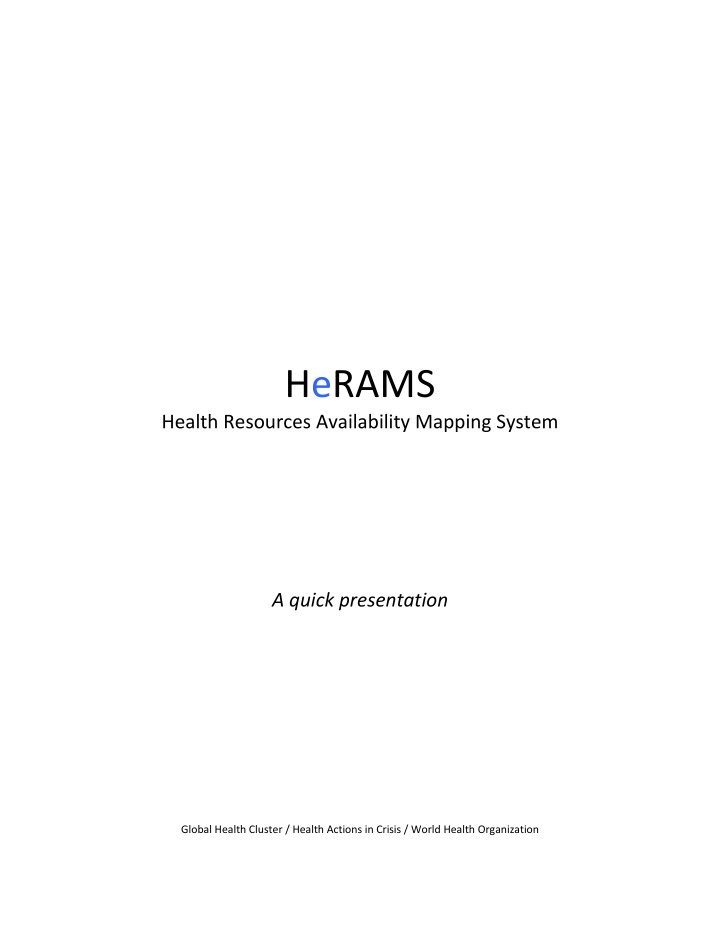



HeRAMS Health Resources Availability Mapping System A quick presentation Global Health Cluster / Health Actions in Crisis / World Health Organization
Preface Evaluations on Health Cluster Implementation regularly highlight the "lack of data for decision making" as a major gap. Defining an analysis framework and developing tools to support its implementation have therefore been key activities of the Global Health Cluster (GHC) over the passed years. The Core Set of Indicators (see attached document) lists the indicators that are key to decision making and more particularly to Situational Analysis and Monitoring, Coordination, Advocacy and Fund Raising. HeRAMS has been developed to support the collection, collation, management, analysis and dissemination of indicators A1 to A8 dealing specifically with the aspects of Resources and Services Availability which are key in respect to the functions of the Health Cluster. I. Problem statement / Issues to be addressed If data on health resources and services availability is often available, experience has shown that the large variety of processes, methods and tools used to generate this data often prevent the generation of Key Indicators to support informed decision making. The main causes are related to: ‐ Lack of time, resources and access to conduct comprehensive assessments ‐ Lack of comprehensiveness of the data gathered preventing the comparative analysis of gaps and inequities / inequalities in resources allocation ‐ Lack or inadequacy of the data structure preventing adequate management analysis and dissemination of information ‐ Lack of agreed upon standards essential for Inter Cluster Analysis and contextualization of Health Issues with regards to other key sectors involved in the response HeRAMS aims at ensuring that: ‐ Assessment and monitoring of health resources and services availability can be conducted systematically and quickly despite limited time, resources and accessibility ‐ Assessment and monitoring is exhaustive and homogeneous over the area of concern ‐ Data structure is a meaningful disaggregation of the information in its most granular form to allow proper management, analysis and dissemination of information ‐ Standards are enforced throughout the information cycle (collection, management, analysis, dissemination) allowing for Inter Cluster Analysis to take place
II. How does HeRAMS intends to address those challenges? An approach tailored to the challenges inherent to Humanitarian Interventions In order to address the limitation in time and resources as well as the lack of accessibility the cluster will face, HeRAMS limits the data collection to the MINIMUM information that is needed to generate Key Indicators. This allows data to be collected centrally (usually at the level at which the Cluster is deployed) through structured interviews between HCCs and Program Managers of Cluster Partners. Avoiding the need for field visits considerably reduces the amount of time and resources (both human and financial) needed to complete the assessment. It also allows assessing areas that may otherwise be inaccessible. The approach has moreover recently evolved towards i ‐ HeRAMS. This initial version has considerably increased the speed at which data is gathered and analysed. As opposed to a traditional "quick and dirty" assessment, this version however still ensure high quality of information management. A Standardized Data Structure Defining a adequate Data Structure is key for any assessment and often a reason of the failure in analysing the data gathered. HeRAMS proposes a structure that guarantees GHCs' Key Indicators can be generated and monitored over time, as needed by the Cluster. Enforcement of Standards HeRAMS promotes and enforces a certain number of standards during the various phases of the Information Management Cycle (Collection, Analysis, Dissemination) that will ensure comparability of the data over time (monitoring) as well as comparability across clusters. In addition, the enforcement of these standards make the data gathered through HeRAMS GIS ‐ compatible, therefore allowing for cartographic representation of the analysis. Automated Analysis HeRAMS is now fitted with a full section of automated analysis which will provide both the figures (raw and %) as well as the graphs representing each of the Indicators chosen by the cluster and therefore increasing the speed and facilitating the generation of key analysis to support decision making.
Raw Data Indicators Graphs This screenshot shows the section where indicator are automatically provided. In this case indicators are provided by districts and also already available under the form of graphs. This section as its name indicates automatically updates as new data is entered. Graphs Raw data + Indicators This screenshot shows the second analysis section devoted to Services Availability where Ad Hoc Analysis, based on Clusters Specific needs may also be led automatically. This section provides again raw data, indicators as well as graphs that may be used as such in presentations, reports, etc. and allows users to dissect Services Availability along any of the criteria needed for their work (Geographical Location, Services Provider, Type of Health Facility, etc.)
III. Why use HeRAMS and particularly i ‐ HeRAMS? i ‐ HeRAMS is probably to date the easiest and lightest to implement as well as the fastest way for the cluster to ensure Key Indicators are measured, monitored and provided to decision maker to support their efforts in analysing and monitoring the situation in terms of resources and services availability, humanitarian response and gaps still to be addressed as well as for coordination, advocacy and fund raising
Recommend
More recommend